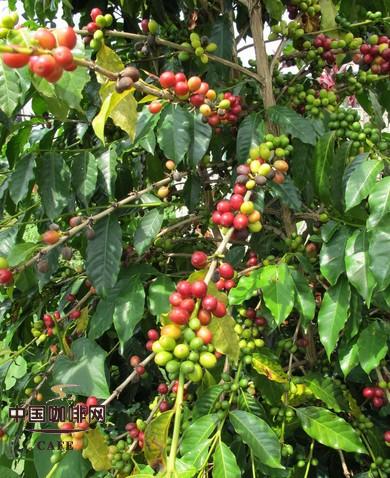Basic knowledge of boutique coffee varieties of coffee trees

Coffee is a perennial evergreen shrub or small tree of Rubiaceae. It is a kind of horticultural perennial economic crop with the characteristics of fast-growing, high yield, high value and wide market. Wild coffee trees can grow to 5 to 10 meters tall, but coffee trees grown on plantations are cut to less than 2 meters in order to increase fruit yield and facilitate harvesting. Coffee tree opposite leaves are long oval, leaf surface smooth, terminal branches are very long, few branches, and flowers are white, open at the base of the petiole connecting branches.
Arabica coffee trees can be divided into two main species: Coffea Arabica and Coffea robusta/Coffea Canephora. There are also minor species, such as Coffea Liberica and Coffea Arabusta, but they are rarely seen on the market.
Robusta beans Robusta coffee trees can grow on flat ground, are more resistant to disease, and yield more. Compared to Arabica beans, Robusta beans are round in shape, with a slightly swollen side in the middle and straight grooves reminiscent of soybeans, while Arabica beans are longer, with zigzag grooves, a bit like half a peanut.
Robusta beans generally taste poorer, caffeine content is 2 to 3 times that of Arabica beans, cheap, mostly for the production of large coffee industry instant coffee or low-cost products. Arabica coffee trees are suitable for growing on fertile slopes with good drainage at altitudes of about 1,000 to 2,000 meters. The climate for growth cannot be too humid, but it still needs continuous rainy seasons and abundant rainfall.
During the day, they prefer mild temperatures and less than two hours of direct sunlight, so in the absence of the afternoon showers or fogs that are reported daily, local farmers must plant many taller trees in the coffee garden to provide shade. At night, they want to have around ten degrees Celsius but not too cold, because too warm will make coffee berries grow too fast to produce small, strong coffee beans; if it is cold enough to frost, the coffee tree will freeze to death.
Based on these characteristics, most of the land suitable for Arabica coffee growth is located between the Tropic of Capricorn and the Tropic of Capricorn, which is also known as the Coffee Zone/Coffee belt.
At present, coffee as an elegant, fashionable, high-grade beverage has long been popular all over the world, and has been listed as the world's three major beverages (coffee, tea, cocoa) first, coffee cultivation also throughout the world's 76 countries and regions, only 1983-1984, the world's coffee production reached 5.5 million tons, exports of 4.2 million tons, of which known as the "coffee kingdom" known as South America Brazil's production and exports the most. However, the hometown of coffee is not Brazil, but Ethiopia in Africa. Up to now, there are large wild coffee forests in the dense jungle of Kafa Province in the southwest of the country. The word "coffee" comes from the place name "Kafa".
Important Notice :
前街咖啡 FrontStreet Coffee has moved to new addredd:
FrontStreet Coffee Address: 315,Donghua East Road,GuangZhou
Tel:020 38364473
- Prev

Roasting knowledge of coffee beans roasting is the finishing step for coffee beans
Baking is equivalent to giving coffee beans the finishing touch. The flavor of the coffee bean itself is latent, and only moderate baking can attract its amorous feelings, just as dry wood needs fire. In the eyes of experts, 80% of the factors that determine the taste of coffee come from raw beans and 20% depend on roasting. Baking is divided into three types: deep, medium and shallow, and these three baking methods are not superior to each other.
- Next

Drinking coffee healthily and regularly is good for your health.
Although coffee tastes good, in the 20th century, experts believed that coffee was no different from liquid poison. Drinking too much was harmful and easy to cause the heart.
Related
- Beginners will see the "Coffee pull flower" guide!
- What is the difference between ice blog purified milk and ordinary milk coffee?
- Why is the Philippines the largest producer of crops in Liberia?
- For coffee extraction, should the fine powder be retained?
- How does extracted espresso fill pressed powder? How much strength does it take to press the powder?
- How to make jasmine cold extract coffee? Is the jasmine + latte good?
- Will this little toy really make the coffee taste better? How does Lily Drip affect coffee extraction?
- Will the action of slapping the filter cup also affect coffee extraction?
- What's the difference between powder-to-water ratio and powder-to-liquid ratio?
- What is the Ethiopian local species? What does it have to do with Heirloom native species?

